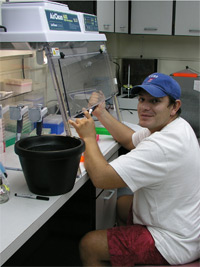Author: Nikolaos Schizas, Ph.D.
Institution: University of Puerto Rico Mayaguez
Year: 2006
Asexually reproducing organisms accumulate deleterious mutations and potentially limit the range of responses when subjected to changing environmental or biotic stresses. In reef-building corals, increased propagation through asexual reproduction will reduce the genetic variability leading to genetically monomorphic coral reefs. Less diverse communities are less resilient to environmental perturbations and perhaps more susceptible to extinction. The recent and drastic decline of Acropora in the Caribbean poses the question if the evolutionary future of the most important coral reef builders is jeopardized. If the majority of Acropora communities are composed of undifferentiated clonal individuals no new genetic variation can be introduced to the gene pool, except the slow process of mutation. Even if local Acropora communities are sexually reproducing, recombination will not yield new genomic combinations.

The purpose of this study is to determine the number and size of clonal lineages of Acropora palmata and A. cervicornis in the coastal reefs of Puerto Rico by using mitochondrial and nuclear genes from individual specimens. Gaining more information about the size and number of clones will lead to estimates of population structure, effective population size, and migration rates between populations in Puerto Rico.
Our preliminary data so far shows that there is little or no genetic variation within or among colonies of both species. The calmodulin intron, Pax-C intron, and the mitochondrial control region have shown very little genetic variation among colonies of Acropora cervicornis and A. palmata in La Parguera, southwest Puerto Rico. However, the sample size analyzed is too small to draw any conclusions about the genetic composition of these corals. More colonies have been sampled, not only in La Parguera but also in other localities around Puerto Rico, in order to get a better understanding of the genetic variation within and among reefs. Currently, we are in the process of analyzing these additional samples.
References & more
- Research reports: August 2006, February 2006, October 2005, June 2005, February 2005
- Garcia -Reyes J., Schizas N.V. (2010) No two reefs are created equal: fine-scale population structure in the threatened coral species Acropora palmata and A. cervicornis. Aquatic Biology 10: 69-83. doi: 10.3354/ab00254
